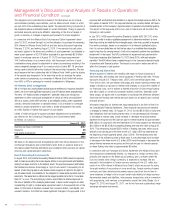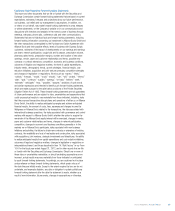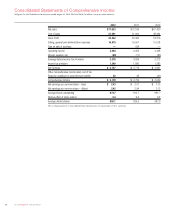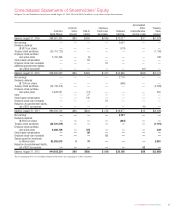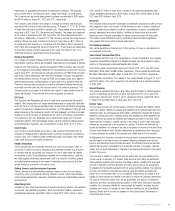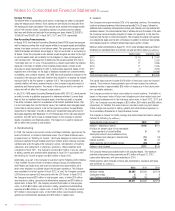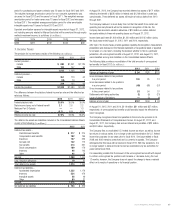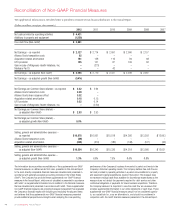Walgreens 2012 Annual Report Download - page 36
Download and view the complete annual report
Please find page 36 of the 2012 Walgreens annual report below. You can navigate through the pages in the report by either clicking on the pages listed below, or by using the keyword search tool below to find specific information within the annual report.
Notes to Consolidated Financial Statements (continued)
34 2012 Walgreens Annual Report
Generally, changes in estimates of expected future cash flows would have a similar
effect on the estimated fair value of the reporting unit. That is, a 1% change in estimated
future cash flows would change the estimated fair value of the reporting unit by
approximately 1%. The estimated long-term rate of net sales growth can have a
significant impact on the estimated future cash flows, and therefore, the fair value
of each reporting unit. For the reporting unit whose fair value exceeded carrying value
by less than 10%, a 1% decrease in the long-term net sales growth rate would have
resulted in the reporting unit failing the first step of the goodwill impairment test.
Of the other key assumptions that impact the estimated fair values, most reporting
units have the greatest sensitivity to changes in the estimated discount rate.
A 1% increase in estimated discount rate for the reporting unit whose fair value
exceeded carrying value by less than 10% would also have resulted in the reporting
unit failing step one. The Company believes that its estimates of future cash flows
and discount rates are reasonable, but future changes in the underlying assumptions
could differ due to the inherent uncertainty in making such estimates.
Changes in the carrying amount of goodwill consist of the following activity
(In millions) :
2012 2011
Net book value – September 1
Goodwill $ 2,045 $ 1,915
Accumulated impairment losses (28) (28)
Total 2,017 1,887
Acquisitions 120 158
Other 24 (28)
Net book value – August 31 $ 2,161 $ 2,017
“Other” primarily represents immaterial purchase accounting adjustments for the
Company’s acquisitions.
The carrying amount and accumulated amortization of intangible assets consists
of the following (In millions) :
2012 2011
Gross Intangible Assets
Purchased prescription files $ 984 $ 913
Favorable lease interests 388 385
Purchasing and payer contracts 334 308
Non-compete agreements 120 95
Trade name 189 71
Other amortizable intangible assets 4 4
Total gross intangible assets 2,019 1,776
Accumulated amortization
Purchased prescription files (417) (338)
Favorable lease interests (109) (76)
Purchasing and payer contracts (119) (94)
Non-compete agreements (53) (43)
Trade name (32) (11)
Other amortizable intangible assets (3) (2)
Total accumulated amortization (733) (564)
Total intangible assets, net $ 1,286 $ 1,212
Amortization expense for intangible assets was $255 million in fiscal 2012,
$219 million in fiscal 2011 and $182 million in fiscal 2010. The weighted-average
amortization period for purchased prescription files was seven years for fiscal 2012
and 2011. The weighted-average amortization period for favorable lease interests
was 11 years for fiscal 2012 and 2011. The weighted-average amortization
6. Goodwill and Other Intangible Assets
Goodwill and other indefinite-lived intangible assets are not amortized, but are
evaluated for impairment annually during the fourth quarter, or more frequently if
an event occurs or circumstances change that would more likely than not reduce
the fair value of a reporting unit below its carrying value. The Company adopted
in fiscal 2012 ASU 2011-08, Testing Goodwill for Impairment, which permits a
qualitative assessment to determine whether it is more likely than not (a more than
50 percent likelihood) that the fair value of a reporting unit is less than its carrying
amount, which would then require performing step one of impairment testing.
Otherwise, no further evaluation would be necessary. As part of the Company’s
impairment analysis for each reporting unit, the Company engaged a third party
appraisal firm to assist in the determination of estimated fair value for each unit.
This determination included estimating the fair value using both the income and
market approaches. The income approach requires management to estimate a
number of factors for each reporting unit, including projected future operating
results, economic projections, anticipated future cash flows and discount rates.
The market approach estimates fair value using comparable marketplace fair
value data from within a comparable industry grouping.
The determination of the fair value of the reporting units and the allocation of that
value to individual assets and liabilities within those reporting units requires the
Company to make significant estimates and assumptions. These estimates and
assumptions primarily include, but are not limited to: the selection of appropriate
peer group companies; control premiums appropriate for acquisitions in the
industries in which the Company competes; the discount rate; terminal growth
rates; and forecasts of revenue, operating income, depreciation and amortization
and capital expenditures. The allocation requires several analyses to determine fair
value of assets and liabilities including, among other things, purchased prescription
files, customer relationships and trade names. Although the Company believes its
estimates of fair value are reasonable, actual financial results could differ from
those estimates due to the inherent uncertainty involved in making such estimates.
Changes in assumptions concerning future financial results or other underlying
assumptions could have a significant impact on either the fair value of the reporting
units, the amount of the goodwill impairment charge, or both. The Company
also compared the sum of the estimated fair values of its reporting units to
the Company’s total value as implied by the market value of its equity and debt
securities. This comparison indicated that, in total, its assumptions and estimates
were reasonable. However, future declines in the overall market value of the
Company’s equity and debt securities may indicate that the fair value of one or
more reporting units has declined below its carrying value.
One measure of the sensitivity of the amount of goodwill impairment charges to
key assumptions is the amount by which each reporting unit “passed” (fair value
exceeds the carrying amount) or “failed” (the carrying amount exceeds fair value)
the first step of the goodwill impairment test. The Company’s reporting units’ fair
values exceeded their carrying amounts by less than 10% to more than 140%.
The fair value of one reporting unit exceeded its carrying amount by less than 10%.
Goodwill allocated to this reporting unit was $255 million at May 31, 2012. For this
reporting unit, relatively modest changes in the Company’s key assumptions may
have resulted in the recognition of a goodwill impairment charge. The Company’s
Long Term Care Pharmacy’s goodwill was impaired by $16 million in fiscal 2010
as a result of the asset sale agreement with Omnicare, Inc., which was signed
on August 31, 2010.


